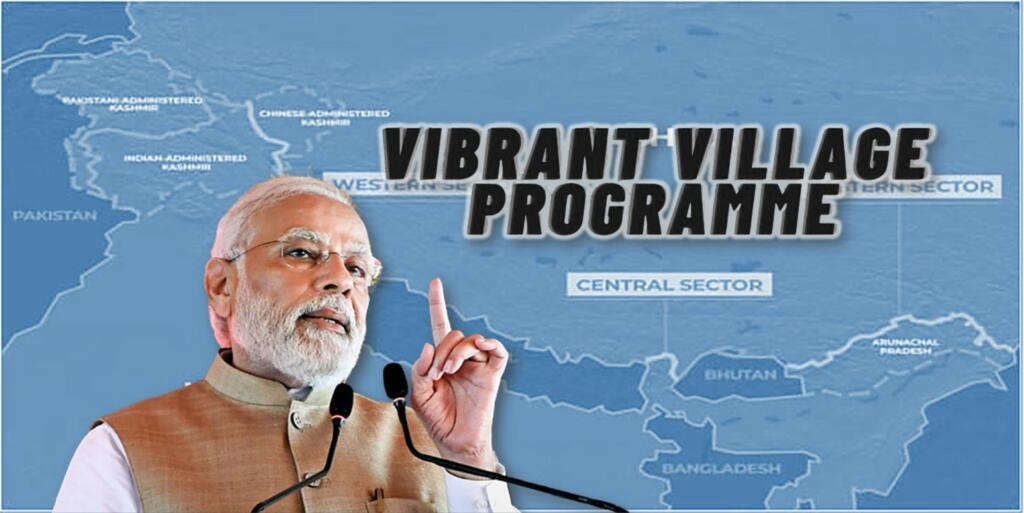The borders are guarded by valour and sacrifices of the men who stand on it and not by logistic and technical superiority. The line best fits the Indian Army which is famous throughout the globe for its meritorious proficiency at ground zero. The Indian army holds the accolade of being the deadliest defence forces in the world.
However, the Government of India is aware of the difficulty faced by our forces. So, it has come up with massive projects to meet the logistical and infrastructural needs of our brave hearts at the borders. The current regime has been developing massive infrastructure along the difficult terrains as part of the initial endeavour. However, the government now seems to be moving towards the second phase of fortifying the borders by speeding up the Vibrant Villages Programmes.
Border redevelopment: India to bash China in its own game
Amidst the growing tension with the Chinese on the eastern front and terrorist nation on the West, the Chief of Defence Staff (CDS) General Anil Chauhan has made a significant statement. The CDS asserted that there are sizable uninhabited areas in Uttarakhand that are far away from the last villages of the state towards the border. The government should prioritize the efforts to repopulate these places. And if that proves difficult, he suggested exploring the possibility to promote border tourism there instead.
The time of the statement highlights the gravity of the situation, as unoccupied villages can be turned into breeding grounds of terrorism. They could prove to deter the efforts of the defence forces in event of prospective war. Further, these areas could be used for incursion into India, thereby risking national security.
Shah’s plan to fortify the borders
The statement however, concurs with the statement made by Home Minister Amit Shah at a different gathering. The Chanakya of contemporary India, while addressing the Chief Ministers of various states at a meeting of Eastern Zone Council, opined the responsibility of the border security vested not only on the Border Security Forces (BSF) but equally on the Border States as well.
That is to say, if both the statements are taken together, it clearly suggests that the Centre is looking forward to repopulating the border areas. It also seems to be planning the development of infrastructural growth of the border areas to the next level. Evidently, the statement is in line with the move of the government to incorporate a special package under the Vibrant Villages Programme in the Budget 2022-23.
Policy on Vibrant Villages Programme
The special package incorporated under the recent budget of the Vibrant Villages Programme will help border villages in many ways. It will ensure that the border villages that frequently missed out on the development benefits because of their small populations, poor infrastructure and lack of connectivity would be connected with the policies of the Centre.
The policy change would be significant in the development of the societies around the border. It would also aid the defence forces in marking the unmanned borders. It would further lead to a holistic development of the farfetched border regions. The action can be said to be an effort to combat Chinese “model villages” along the LAC (Line of Actual Control).
Infrastructural progression along the borders
The security of a nation rests on the defence of the borders. But, for a nation like ours, which has a coastline of 7,516.6 kilometres, including island territories, and 15,106.7 kilometres of land borders, the defence of the frontline becomes a hard-hitting task. Despite that, the Indian defence forces have been guarding the porous borders with great valour. On the contrary, due to the inefficiency of the previous governments, a major portion of the eastern border remains unmarked.
However, the recent government has gone out of the way to carry out border infrastructural development at a rapid pace. Owing to the zeal with which the border development is fructifying, the Chinese have started to panic. They have not only hastened up their development works around the border of LAC, but on regular intervals, create hurdles for India using Salami Slicing.
On the contrary, the Government of India is undertaking the India-China Border Roads (ICBRs, ICB Roads) project. Under the project, critical roads, bridges and tunnels will be built in order to expand infrastructure along the Sino-Indian border. The ICBR project was largely prompted in contrast to Chinese infrastructure expansion along the Indian frontiers.
Evidently, under the auspices of the “Border Infrastructure and Management Fund” (BIMF) of the Ministry of Home Affairs, India is currently building at least 177 roads along the LAC. The roads total more than 10,023 kilometres (6,228 mi) in length.
This comprises 104 new roads totalling more than 6,700 km (4,200 mi) in length under ICBR-II (Phase-II) approved in 2020, as well as 73 roads totalling 3,323 km (2,065 km) in length under ICBR-I (Phase-I) granted in 2005.
Further, the government has decided to extend the Umbrella scheme of Border Infrastructure and Management (BIM) from 2021–2022 to 2025–2026. A core sector programme called “Border Infrastructure and Management” (BIM) has been maintained throughout the 15th Finance Commission cycle, which runs from 2021–2022 to 2025–2026.
The plan will make the border infrastructure stronger in order to enhance border management, law enforcement and border protection. The BIM plan will assist in building infrastructure, such as border fences, floodlights, technology solutions, border roads, and Border Outposts (BOPs)/Company Operating Bases (COBs). These infrastructures will help safeguard the borders between India and Pakistan, Bangladesh, China, Nepal, Bhutan, and Myanmar.
Support TFI:
Support us to strengthen the ‘Right’ ideology of cultural nationalism by purchasing the best quality garments from TFI-STORE.COM
